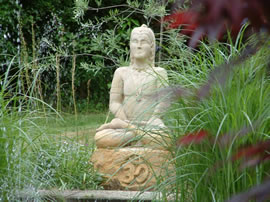Patanjali Yoga Sutras – Lachu Bharwaney
(Lachu Ji was among the first Trustees of the Centre and served on the Executive Committee until he decided to move with family to India and settle there permanently. He is at present living in Puna near Bombay. As he is a Life Member we keep in touch with him through correspondence and sending him our magazine)
Most of you would be aware of the treatise written by the sage Patanjali now commonly known as Patanjali Yoga Sutras. I have always felt that rarely any practitioner of Yoga (especially in the West) pays attention to this book. I think it is extremely important for those of you who practice and teach Yoga seriously to understand the importance of this little book.
The sage Patanjali makes two very important declarations in this book – one near the beginning and the other towards the end. The first one says “the purpose of yoga is to control the fluctuations of the mind” (not to control the mind). The second appearing towards the end declares that “any student who perfects the above practices will see his TRUE SELF.”
I would like to explain that the nature of the mind is to think. Therefore one should not waste time and effort to try to stop the mind from thinking. One should use the quality of the mind – which is the ability to concentrate on a single idea or thought – to transcend the mind. The mind is a great stumbling block on the spiritual journey to self-realisation but we have to bypass the mind with the help of the mind. You have to use steel to cut steel.
In between the two declarations he outlines the practices:
Yama & Niyama: The discipline of following these is to help the sadhak to control the fluctuations of the mind, viz. lust, anger, greed, attachment and vanity. The details are clearly mentioned in the book and are easy to understand. Therefore, I won’t go into the details of these.
Asana & Pranayam : These are for the body to stay healthy so that the following spiritual practices can be perfected. Most of you practice Asana & Pranayam to the exclusion of other practices. Therefore, there is generally no spiritual progress.
At this point it is important to understand that no spiritual progress towards the ultimate objective of realising the Self can take place if the heart and the mind are not pure. Therefore it is absolutely essential to observe all the yama and niyama.
Having learnt to sit quietly for a period of time without moving, the sage instructs us to practice Pratyahara – withdrawal of senses. This means that the mind should not receive any external stimuli. Start with sitting comfortably with the back erect preferably sitting on the floor. If you can-not sit on the floor then sit in a straight backed chair with feet flat on the floor so that the breath is not restricted. Close the eyes lightly, slowly eliminate all the sounds you can hear by acknowledging these and moving on to the next one until all the sounds have been eliminated. Do not burn any incense or light a candle.
After withdrawing the senses practice DHARNA. Dharna means to contemplate. Look at the Third Eye (spiritual eye or the ajna chakra) with the external eyes closed. The third eye is located about 1 cm on top the nose and half an inch inside the forehead. You may watch your breath going in and out of your nostrils, you may contemplate on the question, ”Who am I?” or you may contemplate on your ishta deva or your personal God/deity.
At the deepest level of Dharna you automatically go into the state of Dhyana – the state of meditation. Please understand that meditation is not a process, it is a state of being and one enters into this state at the deepest level of contemplation.
It is like going to sleep. When the body is tired and needs rest, you lie down on the bed and hope to fall asleep. In a similar manner when your contemplation becomes deep, you go into the state of meditation (dhyana).
When Dhyana becomes deep, you enter into the state of Samadhi. There is no equivalent word in English for this. Up to the stage of savikalpa samadhi one is still aware of the duality of being. When the sadhak enters into the state of nirvikalpa samadhi – the soul is said to open the door of the spiritual eye and look at the world.
What does it see? It sees only ITSELF. There is no sense of duality. Only THE SELF remains.
This is the True Self Patanjali promises the sadhak will see if he perfects the practices.
I wish to say that the above is my understanding of the practices and others may have different understanding and experience. The important thing is to follow the discipline if you are really interested in knowing THE TRUE SELF.
May God bless your endeavour.
Lachu Bharwaney
25th April 07
Pune, India.
